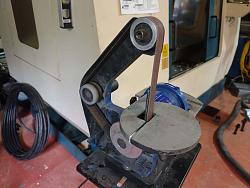If you are running CNC, the static must not be getting into it or you would crash. I'm sure your machine body is grounded so you should not get shocks from static discharge by touching it.
Static discharge current could be flowing through the motor's shaft, bearings, and into ground. My guess is that if there are sparks, they occur millions of times a minute. If the motor hasn't failed yet, it is probably fine.
Rick



 LinkBack URL
LinkBack URL About LinkBacks
About LinkBacks



 Reply With Quote
Reply With Quote


Bookmarks